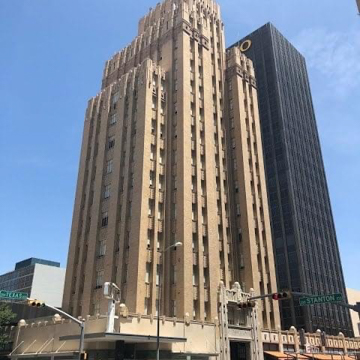Charles Bassett built this fifteen-story office building, named for his father, Oscar T. Bassett, who came to El Paso from Vermont in 1880 by stagecoach and believed that the town would grow rapidly with the coming of the railroads. In 1881, Oscar Bassett and his partner, Charles R. Morehead, organized the first bank in El Paso. For decades Bassett owned a building-supply company and invested his considerable revenues in area real estate, and he helped organize the first school district in 1882.
The Bassett Tower’s one-story podium occupies a quarter of a city block. The slender fourteen-story tower above is composed of four parallel brick-clad slabs stepping up in ascending sequence to a central tower, which is capped with a pyramidal roof. Windows are recessed between brick piers, creating deep vertical channels. In a period when most office buildings had at least one unornamented side, the Bassett Tower is fully articulated and decorated on all sides. The principal entrance features elaborate terra-cotta ornamentation (including what is said to be a representation of Trost’s mustachioed face centered over the doorway, along with several other faces). At the top of each of the building’s slabs, sculpted eagles look out over the city. The composition was influenced by Eliel Saarinen’s second-place entry in the Chicago Tribune competition of 1922, which generated similar towers across the country. The year before, the Trosts had completed the Luhrs Tower (1929) in Phoenix, a virtual duplicate of the Bassett except that its ornament has a strong Southwestern flavor while the Bassett’s ornament is more New York City/Paris-inspired Art Deco.
Trost designed hotels in Marathon (FV14), Marfa (FV22), Alpine (FV8), and Van Horn for Charles Bassett’s Gateway Hotel chain, developed along the rail lines to encourage tourism in West Texas. In 2014 developer Lane Gaddy bought the Bassett Tower and rehabilitated it as a Starwood Aloft hotel.
The Bassett Tower shares its block with El Paso’s tallest building, the twenty-one-story, dark glass curtain-wall-clad Wells Fargo Bank Building (State National Bank Building; 1971, Charles Luckman Associates, with Kuykendall, McCombs, Middleton and Staten) at 221 N. Kansas Street. Confronting the Bassett Tower across Texas Avenue at number 304 is El Paso’s major downtown building of the 1950s, the eighteen-story Blue Flame Building (El Paso Natural Gas Building) of 1954 by Carroll and Daeuble Associates. A bulky tower, it is faced with aluminum-and-glass curtain walls framed by vertical stands of brown brick.


